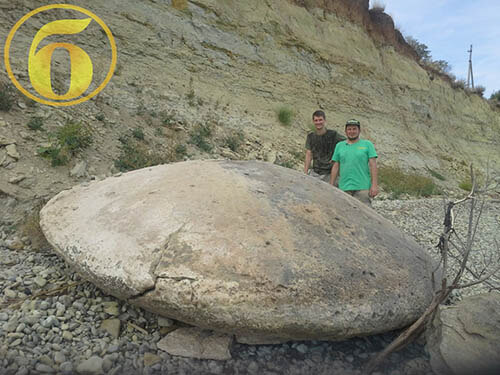
We’ve been working hard to create the best UFO, Alien & Paranormal stories for several years now and we’re excited to share that we just recently launched our youtube channel. We’re releasing one new alien, ufo video each day. Make sure to head over to the UfoHolic youtube channel, subscribe and tap the bell in the top right for notifications to see new videos when they come out. Subscribe to our Ufo videos by clicking here.
A Russian research group called Kosmopoisk have recently dug up a strange disc-shaped stone bearing an uncanny resemblance to the classic UFO shape. Initial geological analysis of the object revealed an age of over one million years.
The expedition was led by UFO researcher Vadim Chernobrov, a former aerospace engineer who dedicated himself to the study of strange artifacts such as the recently discovered ancient disc. Chernobrov and his team began excavating an area in the Volgograd region after local legends piqued their interest.
This area has always been steeped in mythology and folklore,” Chernobrov told a local newspaper. “For as long as they remember, the locals have been passing down stories about dragons made of metal, not flesh. There are also tales of strange travelers who came and went in the most mysterious of ways.”
Excavations began early this month and the group made their first major discovery in the evening hours of September 8. Buried in a remote area in the Medveditskaya mountains was a huge stone disc, measuring approximately 13 feet in diameter and weighing several tons. Apart from its resemblance to modern representations of flying saucers, the artifact possesses some unique characteristics.
For starters, it is eerily symmetrical and quite similar to the stone discs NASA photographed on Mars. Even stranger is the fact that the object features metallic inclusions on its surface. The inclusions have been identified as tungsten, a hard, rare metal found naturally on Earth only in chemical compounds. Also known as wolfram, this chemical element is very resistant and can withstand exceedingly high temperatures.
It’s interesting to note that tungsten is routinely used in advanced engineering projects whenever radiation shielding is needed.
Intrigued by this aspect, the Kosmopoisk group decided the disc should be subjected to further tests and it was taken to the Zhirnovsky Museum for an in-depth analysis.
This isn’t the first disc discovered in the area by Chernobrov and his team but it surely is the strangest:
We managed to find a dozen of these stone discs,” he told the Volgograd Gazette. “But we never found such a unique one. Others had a diameter of no more than 3 feet and we were able to publish the findings. The biggest of them was found in the Kuzbass and had a diameter of 6 feet. This one is twice as big.”
Earlier this year, Siberian coal miners pulled out two similar, albeit smaller stone discs from a depth of over 130 feet. The larger of the two measured four feet in diameter and weighed approximately 440 pounds. A number of mammoth bones recovered by the miners were dated at around 10,000 years old but these ones were found 80 feet below surface, suggesting the discs could be much older. Could these be related to the newest discovery?
It’s impossible to tell and, for all we know, the discs could be natural formations. Your opinion on the matter is welcome, so feel free to use the comment section and let us know what you think.












Humans trying to depict flying saucers